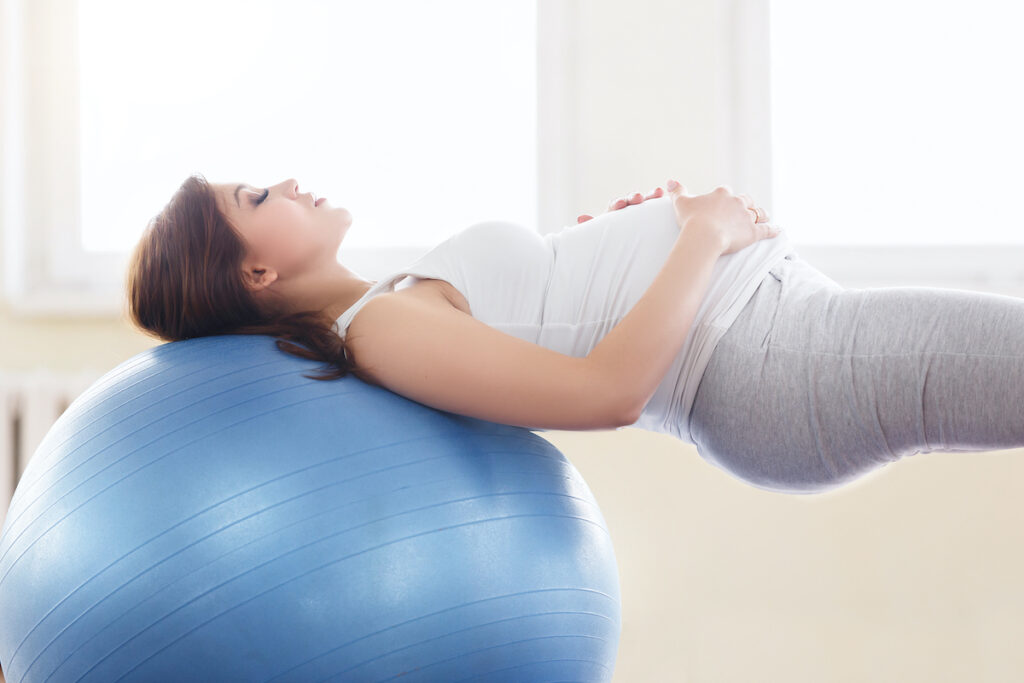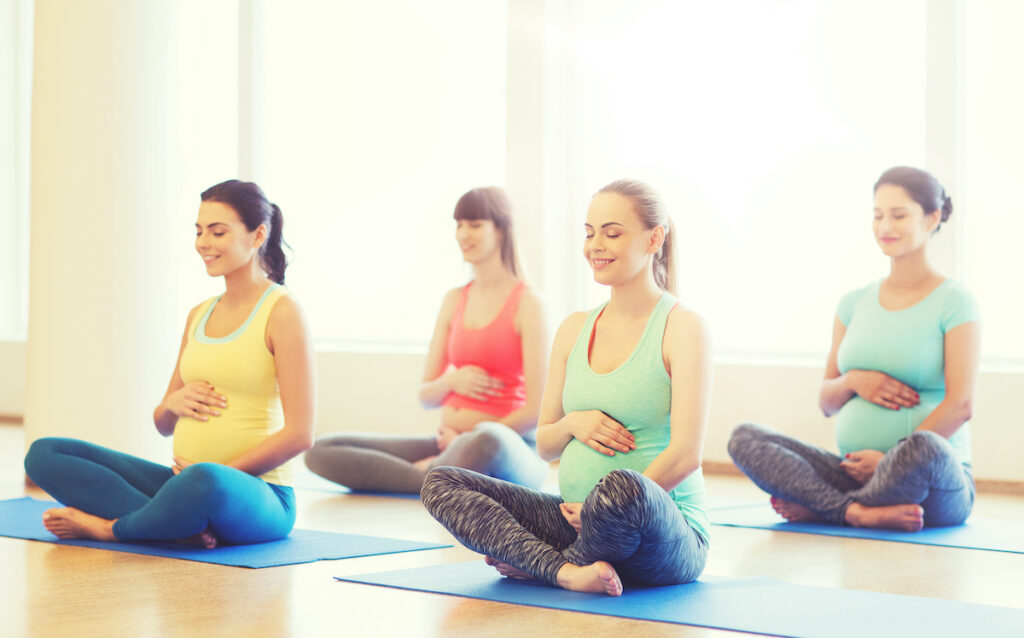
Coined by some as the “baby blues”, postpartum depression is a condition that affects 1 in 10 new mums (NHS, 2018). This startling statistic is a fear for women after giving birth, because postpartum depression comes at a time they are told is supposed to be one of the happiest and most rewarding periods of a woman’s life. Symptoms include feeling a consistently low mood, a loss of enjoyment in activities, difficulty forming a bond with the baby, and can even bring about more frightening thoughts such as harming oneself or the infant (NHS, 2018).
In multiple studies across the years looking more generally at depression, psychologists have cited physical activity and various forms of exercise as a potential method for combating the condition. But can this positive effect of exercise have the same effect in pregnant women? A recent systematic review by Nakamura et al (2019) focused on the effects of physical activity throughout pregnancy as a way of preventing postpartum depression.

Postpartum depression effects 1 in 10 new mothers.
Methods
The researchers conducted a systematic review and meta-analysis of previous studies that have been conducted involving pregnant women with postpartum depression. They searched various databases and screened 2,347 articles for keywords such as pregnancy, postpartum, depression and physical activity, as well as specifying the type of activity done such as walking and yoga. Out of all the articles they screened, they chose 17 articles to include in the meta-analysis.
In order to be included in the analysis, the reviewers required that subjects in the studies had to be diagnosed with depression in a clinical interview or diagnosed by a health professional with a relevant tool measuring depression. Researchers evaluated the quality of the study and potential bias using the Cochrane risk of bias tool for interventional studies (Higgins and Green, 2011) and the Newcastle-Ottawa Scale for observational studies (Wells G.A. et al., 2011).
Results
Can physical activity during pregnancy reduce a woman’s chance of postpartum depression? The results of the meta-analysis show that this could indeed be a possibility. Throughout the 17 different studies analysed, 41.6% of pregnant participants in the study were classified as physically active during their pregnancy and the time spent during each physical activity had a large range between 30 and 150 minutes per week. There were two types of studies analysed in the metal-analysis:
Interventional studies
Pregnant women were given a specific type of physical activity to complete over a period of time in randomised controlled trials (RCTs):
- 3 out of the 6 interventional studies examined showed a significant reduction in postpartum depression during prenatal:
- Hatha yoga courses (Bershadsky et al, 2014),
- aerobic training (Rankin, 2008) and
- prenatal aerobic exercise in water (Aguilar-Cordero, 2018)
- The other 3 showed no noteworthy reduction in postpartum depression rates between the control and intervention groups.
Observational studies
Physical activity was defined as “leisure time activities” or “all of the movements contributing to the total daily energy expenditure”.
- Out of the 11 observational studies included in the analysis, 5 found a significant reduction in postpartum depression when a woman completed prenatal physical activity (Abraham et al, 2001; Claesson et al, 2014; Kowalska et al, 2014; Nordhagen and Sundgot-Borgen, 2002; Symons Downs et al, 2008)
- Another study found that women who completed physical activity for more than five days a week had lower rates of postpartum depression symptoms compared to women who only completed 1 or less days of physical activity (Guida et al, 2012)
- Another study by Shakeel et al (2018) found pregnant women who were physically active (moderate to vigorous activity 3 times a week for at least 150 minutes) had a lower risk of postpartum depression compared to women who completed no physical activity at all.

This reviews suggests a small to moderate reduction in the number of reported cases of postpartum depression in women that completed some form of physical activity consistently throughout their pregnancy.
Conclusions
The authors concluded:
We found a small to moderate reduction in postpartum depressive symptoms among women who were physically active during their pregnancy, especially when regarding the outcomes of intervention studies.
However, they point out that further research is needed before we can conclude that physical activity has a major impact on the mental health of women in the perinatal period. The type of physical activity, duration of activity, as well as the period of pregnancy where physical activity is most effective, should all be further assessed before making a concrete assertion. However, the study points to a promising and potential long-term benefit to a new mother’s mental health.

The type and duration of physical activity, as well as the period of pregnancy where physical activity is most effective should all be further assessed before making a concrete assertion on potential long-term benefits to a new mother’s mental health.
Strengths and limitations
Because there is such a large gap in the literature of using physical activity as a preventative measure for postpartum depression, this review was one of the first of its kind to highlight the need for exploring this potential method. The study included a total of 100,494 participants, but the number of studies actually included in the meta-analysis is still quite low.
Another limiting factor of the study is the fact that many of the studies included in the meta-analysis had moderate to low quality ratings for the methodology used. The reviewers could not always distinguish if a participant completed self-reported measures of physical activity or if they were objectively evaluated. This leads room for error specifically with recall problems, bias, as well as participants reporting socially desirable answers. This issue can lead to inaccuracies within the data, because results that were collected without methodologically sound practices produce untrustworthy results.

The review included >100k participants, but the quality of the included studies was low to moderate, so we cannot be confident in the conclusions.
Implications for practice
The results suggest that there was a small to moderate improvement in the reduction of postpartum depression symptoms amongst women who completed some form of physical activity prenatally. While this discovery may not seem astounding to most, the implications for practice in a clinical setting are considerable. There has been little information gathered about how to reduce and prevent postpartum depression, and the gap in knowledge has resulted in millions of women suffering worldwide from a condition that seems to have no universal treatment that has been proven effective. This study offers some form of guidance for clinicians and other health professionals:
- Physical activity during pregnancy has already been shown to reduce antenatal depression, which is one of the main predictors of postpartum depression (Teychenne and York, 2013)
- Exercise in general promotes many benefits in maternal health such as positive development of the fetus (Nascimento et al, 2012)
- Health care providers often caution women to reduce the amount of physical activity they carry out during their pregnancy, specifically when they feel too tired or stressed (Merkx et al, 2017).
With these newly acquired findings, it would be beneficial for health care professionals to target this information to women who are in the prenatal period or even to women who are planning to become pregnant. Hearing this information from a health care professional could encourage women to include physical activity as a part of their daily regimen. Health care professionals could even refer women to low to moderate intensity physical activity programs, which have already been shown to reduce the risk of prenatal depression (Gong et al, 2015).
As a burgeoning mental health professional, it was extremely difficult for me to watch my aunt suffer from severe postpartum depression for an entire year after she had my little cousin. She was constantly lethargic and could barely feed herself let alone her new baby. It seemed like a miracle when she found a treatment plan tailored to her needs. However, for many others this help seems far away. Although there is still much to be explored about physical activity as a means to reduce postpartum depression, this little inkling of hope gives reassurance to women that there is a potential solution to their baby blues.

The results of the analysis can offer a form of guidance for health care professionals in referring women to physical activity during their pregnancy.
King’s MSc in Mental Health Studies
This blog has been written by a student on the Mental Health Studies MSc at King’s College London. A full list of blogs by King’s MSc students from can be found here, and you can follow the Mental Health Studies MSc team on Twitter.
We regularly publish blogs written by individual students or groups of students studying at universities that subscribe to the National Elf Service. Contact us if you’d like to find out more about how this could work for your university.
Links
Primary Paper
Nakamura, A., Waerden, J. V. D., Melchior, M., Bolze, C., El-Khoury, F., & Pryor, L. (2019). Physical activity during pregnancy and postpartum depression: Systematic review and meta-analysis. Journal of Affective Disorders, 246, 29–41. doi: 10.1016/j.jad.2018.12.009
Other References
Abraham, S., Taylor, A., Conti, J., 2001. Postnatal depression, eating, exercise, and vomiting before and during pregnancy. Int. J. Eat. Disord. 29, 482–487.
Aguilar-Cordero, M.J., Sánchez-García, J.C., Rodriguez-Blanque, R., Sánchez-López, A.M., Mur-Villar, N., 2018. Moderate physical activity in an aquatic environment during pregnancy (SWEP Study) and its influence in preventing postpartum depression. J. Am. Psychiatr. Nurses Assoc 1078390317753675, [Epub ahead of print].
Bershadsky, S., Trumpfheller, L., Kimble, H.B., Pipaloff, D., Yim, I.S., 2014. The effect of prenatal Hatha yoga on affect, cortisol and depressive symptoms. Complement.Therapies Clin. Pract. 20, 106–113.
Claesson, M., Klein, S., Sydsjö, G., Josefsson, A., 2014. Physical activity and psychological well-being in obese pregnant and postpartum women attending a weight-gain restriction programme. Midwifery 30, 11–16.
Gong, H., Ni, C., Shen, X., Wu, T., Jiang, C., 2015. Yoga for prenatal depression: a systematic review and meta-analysis. BMC psychiatry 15 (14).
Guida, J., Sundaram, S., Leiferman, J., 2012. Antenatal physical activity: investigating the effects on postpartum depression. Health 4, 1276–1286.
Higgins, J.P.T., Green, S., 2011. Cochrane Handbook for Systematic Reviews of Interventions.John Wiley & Sons.
Kowalska, J., Olszowa, D., Markowska, D., Teplik, M., Rymaszewska, J., 2014. Aktywność fizyczna i szkoła rodzenia w czasie ciąży a poziom postrzeganego stresu i objawów depresyjnych u kobiet po porodzie. Psychiatr. Pol. 48, 889–900.
Merkx, A., Ausems, M., Bude, L., de Vries, R., Nieuwenhuijze, M.J., 2017. Factors affecting perceived change in physical activity in pregnancy. Midwifery 51, 16–23.
Nascimento, S.L., Surita, F.G., Cecatti, J.G., 2012. Physical exercise during pregnancy: a systematic review. Curr. Opin. Obstet. Gynecol. 24, 387–394.
NHS. (2018, December 10). Postnatal depression. Retrieved from https://www.nhs.uk/conditions/post-natal-depression/
Nordhagen, I.H., Sundgot-Borgen, J., 2002. Physical activity among pregnant women in relation to pregnancy-related complaints and symptoms of depression. Tidsskrift for den Norskelaegeforening : tidsskrift for praktisk medicin, ny raekke 122, 470–474.
Rankin, J., 2008. The Effects of Antenatal Exercise on Psychological Well-being, Pregnancy and Birth Outcomes. John Wiley & Sons.
Shakeel, N., Richardsen, K.R., Martinsen, E.W., Eberhard-Gran, M., Slinning, K., Jenum, A.K., 2018 Physical activity in pregnancy and postpartum depressive symptoms in a multiethnic cohort. J. Affect. Disord. 236, 93–100.
Symons Downs, D., DiNallo, J.M., Kirner, T.L., 2008. Determinants of pregnancy and postpartum depression: prospective influences of depressive symptoms, body image satisfaction, and exercise behavior. Ann. Behav. Med. Publ. Soc. Behav. Med. 36, 54–63.
Teychenne, M., York, R., 2013. Physical activity, sedentary behavior, and postnatal de- pressive symptoms: a review. Am. J. Prev. Med. 45, 217–227.
Wells, G.A., Shea, B., O’connell, D., Peterson, J., Welch, V., Losos, M., Tugwell, P., 2011. The Newcastle-Ottawa Scale (NOS) for Assessing the Quality of Nonrandomised Studies in Meta-Analyses. Ottawa Hospital Research Institute, Ottawa, pp. 2011.
Photo credits
- Photo by freestocks on Unsplash
- Photo by Gift Habeshaw on Unsplash
- Photo by Kaylee Garrett on Unsplash
- Photo by Aleksandr Ledogorov on Unsplash
